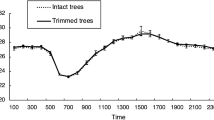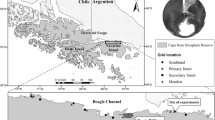Abstract
This study investigates patterns of habitat use and competition in sympatric populations of the bush rat, Rattus fuscipes, and swamp rat, R. lutreolus, in the Blue Mountains National Park, New South Wales, Australia. Radiotracking showed that the home ranges of R. fuscipes tended to occupy woodland more than those of R. lutreolus, whereas use of heath and sedgeland by both species was equal. Home range overlaps were less between the two species than between individuals of R. lutreolus. Trap-captures showed that both species used structurally complex microhabitats, but also that R. fuscipes occupied relatively drier sites with denser leaf litter and taller canopy than R. lutreolus. In a field enclosure containing equal parts dense sedge and woodland, both species spent most time in the sedge. R. lutreolus frequently initiated agonistic behaviour and dominated its smaller congener; subordinate individuals fled or vocalized loudly. To test whether the observed patterns of habitat use of R. fuscipes resulted from habitat selection or competition with R. lutreolus, a field experiment was carried out in which the latter species was removed from two study sites but maintained in two controls. Following removal, the capture rate of R. fuscipes increased some 6.5-fold in sedgeland habitat that had been occupied formerly by R. lutreolus, while capture rates in sedge in the control sites remained unchanged. The rapidity of the habitat shift implicates current or intense competition, mediated by interference. Although interference is a costly process, it may benefit the dominant R. lutreolus by allowing priority of access to preferred moist habitats containing important food or shelter resources. Conversely, R. fuscipes may tolerate interference if it benefits from even temporary access to moist habitats, can reliably detect and avoid R. lutreolus prior to encounters, or has access to drier woodland areas under-used by the dominant species. We suggest finally that extensive gene flow in R. fuscipes may preclude adaptive shifts in habitat preferences in local populations that are sympatric with R. lutreolus, thus reducing the importance of competition but maintaining its intensity over time.
Similar content being viewed by others
Author information
Authors and Affiliations
Additional information
Electronic Publication
Rights and permissions
About this article
Cite this article
Maitz, W.E., Dickman, C.R. Competition and habitat use in native Australian Rattus: is competition intense, or important?. Oecologia 128, 526–538 (2001). https://doi.org/10.1007/s004420100689
Received:
Accepted:
Published:
Issue Date:
DOI: https://doi.org/10.1007/s004420100689




